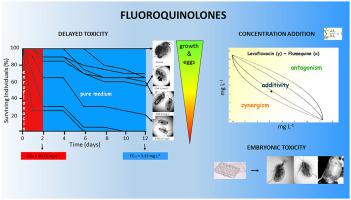Ecotoxicology and Environmental Safety ( IF 6.8 ) Pub Date : 2021-09-16 , DOI: 10.1016/j.ecoenv.2021.112778 Roberta Tolosi 1 , Marco De Liguoro 1

|
Fluoroquinolones (FQs) are antibacterial drugs, used both in human and veterinary medicine, that are currently considered as emerging micropollutants. This study investigated the delayed toxic effects of enrofloxacin (ENR), flumequine (FLU), levofloxacin (LEV) and their binary mixtures in D. magna. For this purpose, a 10-day follow-up in pure medium was added to the standard D. magna immobilization test. During this follow-up, phenotypic alterations were evidenced, which were related to scarce or zeroed egg production and early mortality. Consequently, the EC50 s recalculated at the end of the follow-up were always remarkably lower than those obtained after the 48 h immobilization test: ENR 3.13 vs. 16.72 mg L−1; FLU 7.18 vs. 25.35 mg L−1; LEV 15.11 vs. > 40 mg L−1. To analyse the possible interactions within the binary mixtures, the method of nonlinear additive isoboles was applied. The three compounds showed invariably to follow the principle of concentration addition. Furthermore, as previous experiments showed toxicity of FLU and ENR after embryonic exposure of D. magna at a concentration of 2 mg L−1, an additional two embryonic tests were conducted with identical design: one with 2 mg L−1 LEV and the other with a ternary mixture containing 0.66 mg L−1 of each of the three FQs. The embryos were exposed for three days in vitro to the drug solutions and were then reconducted to pure medium for 21 days observation. Both the tests ended-up with only non-significant effects on growth and reproduction, confirming the lower toxicity of LEV, when compared to ENR and FLU, and the absence of any evident synergistic interaction among the three FQs. Overall, these studies have shown two relevant features related to the toxicity of the three FQs: (1) they give rise to delayed toxic effects in D. magna that are undetectable by the standard immobilization test; (2) their interaction in mixtures follow the principle of Concentration Addition. Both these indications concern the Environmental Risk Assessment of FQs and may be of interest to regulatory authorities.
中文翻译:

新生儿或胚胎暴露后三种氟喹诺酮类药物及其混合物在大型水蚤中的延迟毒性
氟喹诺酮类药物 (FQ) 是一种抗菌药物,可用于人类医学和兽医学,目前被认为是新兴的微污染物。本研究调查了恩诺沙星 (ENR)、氟甲喹 (FLU)、左氧氟沙星 (LEV) 及其二元混合物在大麦格纳菌中的延迟毒性作用。为此,在标准D. magna固定测试中添加了纯培养基中的 10 天随访。在这次随访中,表型改变得到证实,这与产蛋量稀少或归零和早期死亡率有关。因此,在随访结束时重新计算的 EC 50 s总是显着低于 48 小时固定测试后获得的值:ENR 3.13 与 16.72 mg L -1; FLU 7.18 与 25.35 mg L -1;LEV 15.11 对比 > 40 mg L -1。为了分析二元混合物中可能的相互作用,应用了非线性可加等值线法。三种化合物均表现出遵循浓度相加的原则。此外,由于之前的实验表明,在胚胎暴露于 2 mg L -1浓度的D. magna后,FLU 和 ENR 具有毒性,因此以相同的设计进行了另外两项胚胎试验:一项具有 2 mg L -1 LEV,另一项具有含有 0.66 mg L -1的三元混合物三个 FQ 中的每一个。胚胎在体外暴露于药物溶液三天,然后再转入纯培养基中观察 21 天。这两项测试最终都对生长和繁殖仅产生不显着影响,证实了 LEV 的毒性低于 ENR 和 FLU,并且三种 FQ 之间没有任何明显的协同相互作用。总体而言,这些研究显示了与三种 FQ 的毒性相关的两个相关特征:(1) 它们在D. magna中引起延迟毒性作用,这是标准固定测试无法检测到的;(2)它们在混合物中的相互作用遵循浓度加成原理。这两种迹象都与 FQ 的环境风险评估有关,监管机构可能会感兴趣。


























 京公网安备 11010802027423号
京公网安备 11010802027423号